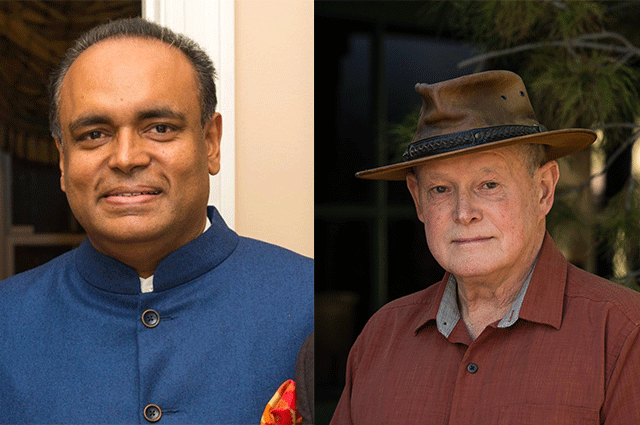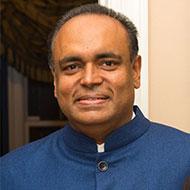A Q&A with 2019 Graduate Alumni Award Winners

This year’s recipients are Tom Varkey, MA in Economics ’92, and Jim Kanagy, MS in Chemistry ’73.
In this Q&A, they discuss their careers, experiences at Tufts, and advice for current graduate students.
Tom Varkey, MA in Economics ’92
Tom Varkey received a BA with distinction from Loyola College (India), an MA in Economics from Tufts University, and an MBA from Harvard Business School. He has gone on to a successful career in financial services and is a Chartered Financial Analyst. Tom has managed portfolios at Stonehill Capital Management since 2001 and has been a partner at the company since 2004. In December 2018, Tom partially retired from Stonehill and is spending more time with his family in India while serving as an advisor to Stonehill on their investments in India. He is also an active angel investor and has seeded and is on the boards of multiple early stage companies. Tom is a Trustee of the Groton School in Groton, MA, and he is on the advisory board of the Harvard South Asian Institute.
1. How did your time as a graduate student at Tufts shape your career?
As a college student in India in the late 1980’s, America was the only destination of choice for anyone interested in further academic training. My goal was always to get my PhD in economics and pursue a career in academics or research. Fortunately, I ended up at Tufts where my plan was to do a master’s in Economics and then go on to do a PhD. While here at Tufts I had the opportunity to take classes in finance and international trade in addition to the rigorous economics classes that were part of the required curriculum. This opened my eyes to the whole world of fixed income investing which combined my interest in all of these areas and has formed the basis of my career for the last 25 years.
2. Did you have any key mentors at Tufts? How did they contribute to your academic growth and/or career path?
As an undergraduate economics student in India you were never really exposed to a lot of macroeconomics and I remember distinctly sitting in on my first macro class with Professor Dan Richards. I was in awe as he exposed me to a whole new world of thinking. He so elegantly got me to appreciate how interconnected the whole world was. For the first time I was able to see the big picture, and this gave me a level of intuition and sophistication that has helped me throughout my career. I started my career as a sovereign analyst managing an emerging market debt portfolio and a currency portfolio where the enthusiasm and fire that Professor Richards lit in me was instrumental in my success in that space.
3. What about your current work excites or interests you the most?
What I like most about my job is that I have the flexibility to look at any investment opportunity irrespective of which area it is in. At Stonehill Capital we are all generalists for the most part and are not constrained by any particular industry or segment. This makes my job so much more interesting and gives me the ability to look at situations with the benefit of experience in multiple industries. This keeps the job fresh and exciting so much so that it doesn’t feel like a job anymore.
4. If you could give one piece of advice to current graduate students in the field of Economics, what would it be?
The one piece of advice I would like to share with the current graduate students is that careers do not progress in a straight line well packaged with bows and ribbons attached. You will have ups and downs and most likely you will have to transform yourself to make yourself relevant. When emerging markets went out of favor I moved into distressed investing. Though it was a new area I was able to leverage my academic background to make a successful career out of distressed debt. Have faith in the education you are getting here at Tufts, keep learning, and most importantly, stay positive.
Jim Kanagy, MS in Chemistry ’73
Jim Kanagy received his BS in Chemistry from Eastern Mennonite University in 1969, his MS in Chemistry from Tufts in 1973, and his JD from Golden Gate University in 1978. Since then, he has gone on to a distinguished career in the patent and scientific patent management realm. From 1985 to 2010, Jim served in the patent group of the company that is now GlaxoSmithKline, with positions that spanned from patent counsel to Vice President of Patents with Clinical Laboratories. In 2010, Jim left GlaxoSmithKline to relocate to Big Valley, Pennsylvania. He currently resides there, managing a fully functional grass farming operation.
1. How did your time as a graduate student at Tufts shape your career?
My time as a Tufts graduate student provided me with a sound basis in chemistry and good research practices and techniques. Professors and grad student contemporaries created a challenging and interesting atmosphere in a safe learning setting where one could make mistakes and learn from them. A talented and interesting group of people. And it was in the library in the Michael wing where I found a book on careers in chemistry talking about patent law. That piece was the impetus for going to law school and into patent law in healthcare.
2. Did you have any key mentors at Tufts? How did they contribute to your academic growth and career path?
Professor of Chemistry Robert Stolow was my advisor, and my key mentor at Tufts. His research program was challenging. His knowledge of chemistry and his approach to research gave me a solid basis in science that served well over the years in my work with researchers in the healthcare field, patent offices, and patent litigation. Understanding the chemistry for synthesizing compounds was and is a critical factor in obtaining intellectual property rights for chemical compounds.
3. What are some of your proudest career moments?
At a high level, obtaining patents on inventions and defending them when the products got to market. Intellectual property, patents and know how, are the primary means by which research costs that run to hundreds of millions of dollars can be recouped. One example is the agreement to license the use of the botulinum toxin, now known as Botox®, for treating Tic douloureux, a painful chronic nerve condition, when I was at Allergan. On a different front, working with GlaxoSmithKline’s IT group and Cambridge Soft to create a first-in-kind online lab notebook tool to replace the paper lab notebook which was no longer useful in the age of large data files from analytical machines. It connected all pre-NDA research operations around the world at GlaxoSmithKline allowing researchers to see everyone’s output in real time.
4. If you could give one piece of advice to current graduate students in the field of Chemistry, what would it be?
I would refer them to a quote by George Bernard Shaw from his work Back to Methuselah that I have found to be a useful guidepost: “I hear you say 'Why?' Always 'Why?' You see things; and you say 'Why?' But I dream things that never were; and I say, 'Why not?”

